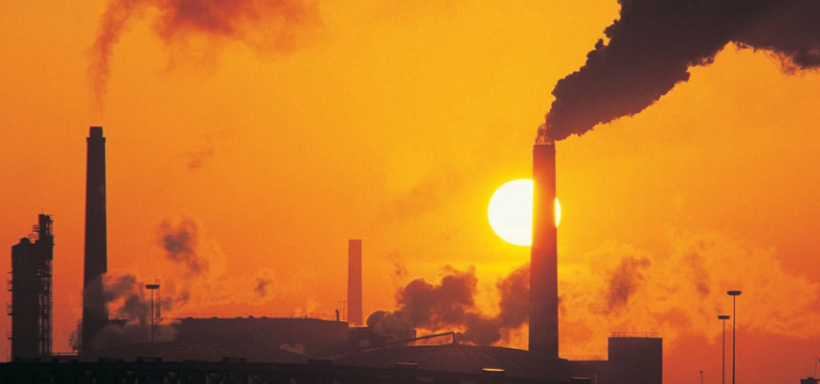Anthropogenic sources of mercury emissions account for about 30% of the total amount of mercury entering the atmosphere each year.
As found in previous global mercury assessments, the main industrial sources of atmospheric mercury are coal burning, mining, industrial activities that process ores to produce various metals or process other raw materials to produce cement. In these activities, mercury is emitted because it is present as an impurity in fuels and raw materials. In these cases, mercury emissions and releases are sometimes referred to as ‘by-product’ or ‘unintentional’ emissions or releases.
The second category of sources includes sectors where mercury is used intentionally. Artisanal and small-scale gold mining (ASGM) is the largest of these, in which mercury emissions and releases result from the intentional use of mercury to extract gold from rocks, soils, and sediments. Other intentional-use release sectors include waste from consumer products (including metal recycling), the chlor-alkali industry, and the production of vinyl-chloride monomer.
Coal burning, and to a lesser extent the use of other fossil fuels, is one of the most significant anthropogenic sources of mercury emissions to the atmosphere. Coal does not contain high concentrations of mercury, but the combination of the large volume of coal burned and the fact that a significant portion of the mercury present in coal is emitted to the atmosphere yield large overall emissions from this sector. The mercury content of coal varies widely, introducing a high degree of uncertainty in estimating mercury emissions from coal burning. Data on mercury content is now available from many countries, including major emitters of mercury.
Mining, smelting, and production of iron and non-ferrous metals are also a large source of global mercury emissions to air, and also a very important sector with regard to releases to water. In the mining and processing of metals, most of the mercury is captured and either stockpiled or sold for use in various products, creating anthropogenic sources associated with intentional use, discussed below. Nonetheless, the volume of ores and metals involved result in large total emissions and releases.
The relatively small volume of primary mercury production makes mercury mining a far smaller source today than it has been in the past.
Cement production, which typically involves the burning of fossil fuels to heat the materials required to make cement, is another major anthropogenic source of mercury emissions. Both the raw materials and the fuel may contain mercury and lead to emissions. The amount of mercury involved varies greatly with the mercury content of these fuels and especially with the raw materials. In some countries, cement kilns are burning increasing amounts of alternative fuels, including wastes that may contain mercury. This may add to the emissions from cement kilns.
Oil refining emits and releases mercury, as oil deposits are known to contain mercury, generally at low concentrations. Mercury is removed from most petroleum products and natural gas prior to combustion, and therefore combustion-related emissions are low. Most of the mercury in crude oil is associated with solid waste that is disposed of in landfills. However, emissions and releases during refining of crude oil do occur and these have been quantified for the first time in the 2010 inventory.
The inventory does not quantify other emissions and releases during oil and gas extraction and transport or from flaring.
Unintentional mercury emissions from these sectors can be reduced by the application of pollution control measures at power plants and industrial plants. Some of the mercury captured is refined and enters the commercial supply chain; however, large amounts of mercury captured in materials such as fly ash and oil refinery waste need to be disposed of.
Some of the resulting wastes are themselves used as raw materials, for example in construction materials, but large amounts are disposed of in landfills, which can thus become a potential source of mercury emissions and releases.
Among intentional-use sectors, Artisanal and small-scale gold mining is a major source for emissions and releases of mercury worldwide. In ASGM, miners use mercury to create an amalgam separating gold from other materials. They then have to separate the mercury from the gold. Calculating emissions from this sector presents a particular challenge because it is typically widely dispersed and often unregulated and may be illegal. Uncertainties regarding release estimates from the ASGM sector are therefore high.
Furthermore, the miners are typically poor and perhaps have little awareness of the hazards of mercury, and pollution control devices may be hard to obtain.
Wastes from consumer products containing mercury can end up in landfills or incinerators.
Mercury is still used in a wide range of products, including batteries, paints, switches, electrical and electronic devices, thermometers, blood-pressure gauges, fluorescent and energy-saving lamps, pesticides, fungicides, medicines, and cosmetics.
Once used, many of the products and the mercury they contain enter waste streams. While mercury in landfills may slowly become re-mobilized to the environment, waste that is incinerated can be a major source of atmospheric mercury, especially from uncontrolled incineration. Incinerators with state-of-the-art controls have low emissions.
Another use of mercury is in dental amalgam for filling teeth. When bodies are cremated, mercury in fillings can be emitted. Mercury can also be emitted and released during production and preparation of fillings and from the disposal or removed fillings.
In addition, mercury from removed fillings can be recycled or go into solid waste and wastewater.
The amount of mercury released in the recycling of scrap metals, for example in secondary steel and nonferrous metal production, is generally assumed to be much lower than that released during primary metal production, which is why the present global inventory only addresses primary metal production. However, lower emissions from recycling may not be the case in all countries. Much of the scrap steel in some countries comes from automobiles that may still have devices that contain mercury, and which may not be removed prior to recycling of the steel. These devices are largely being phased out so mercury emissions from scrap steel may be expected to decrease. However, large differences exist between countries in the way they treat their mercury-containing wastes, including scrap metals that are recycled in secondary metal production.
Mercury is also used in a number of industrial processes. A major industrial use is in the chlor-alkali industry where mercury-cell technology may be used in the production of chlorine and caustic soda.
Mercury is also used as a catalyst in the production of vinyl chloride monomer (VCM) from acetylene, mainly in China.


